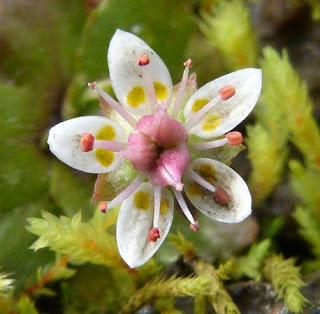So many flowers in a place renowned for it's harsh conditions. I think the first is a stitchwort, Stellaria, then Poa alpina the Alpine meadow-grass.
This really was this colour, I have no idea what it is.
Edible crowberries, Empetrum nigrum is
a bit like lemony blueberries.
A tiny fern, a moonwort, Botrychium lunaria compare the size with the grass.
Alpine bistort, Polygonum viviparum.
Cotton grass, one of several similar species.
Thymus praecox, not quite the same as ours.
Potentilla crantzii, alpine cinquefoil is a tiny version of the garden shrubby ones.
A mossy saxifrage, not sure which.
Starry saxifrage,
Saxifraga stellaris, the rock-breaker, super-powers indeed for so delicate a creature
Old calyx of white sea campion, Silene uniflora. Legend has it that you'll die if you pick it, good for conservation, but more likely because of its cliff edge habitat.
Cousin Silene acaulis mossy campion.
Silene suecica, alpine catchfly, sticky but not carnivorous.
My next challenge has to be mosses & lichens! The acid green moss covers hills like grass, particularly when geothermal activity keeps it steamy.
Smiley faces instead of crop circles, probably some sort of fungus-induced fairy-ring.
Unexpectedly toadstool seem to thrive too.
Not a caterpillar, lichen under a waterfall.
A selection of willows, the last is the woolly willow, like the others, small & ground hugging, the one below all of a foot long.
At last, a real tree, in Thorsmork, about 10 feet high, the biggest we saw, a nice little birch.

Parnassia palustris, the marsh grass of Parnassus in known locally as "gelding (as in castrating horses) button" but I couldn't find out why.
Pinguicula vulgaris, common butterwort, the colour a bit odd as the light was strange, dusky-stormy.
Alchemilla, a small cousin of out garden one.
Dwarf fireweed, Chamerion latifolium or Arctic river beauty is closely related to our willow herb, and like ours spreads "fire" as the leaves redden in autumn.

The alpine bartsia, Bartsia alpina named with stunning originality and occasionally reported in Scotland

Tufted vetch,
Vicia cracca, like ours

Myosotis arvensis, the field forget-me-not, like our garden one.
And finally, somewhat unexpectedly orchids. I'd read about the Northern green, but frogs in great flocks too and many we didn't see.
Dactylorhiza viridis enjoying the swamps like its namesake. For the geeks, recent genetic studies have suggested it should be moved it from Coeloglossum, but experts seem to come to blows over this!
I think these are all northern green orchids, Platenthera hyperborea, but orchid's tendencies to interbreed make them confusing at the best of times, lying in a bog in a gale & sleet-storm doesn't make for good photos or observations!


















































